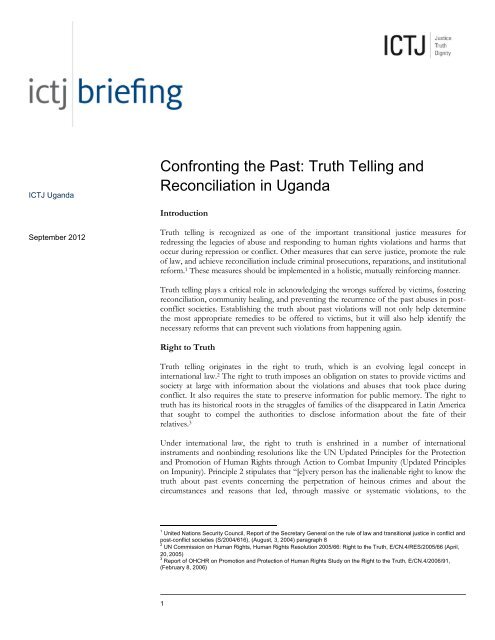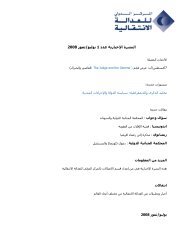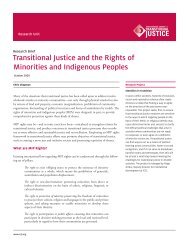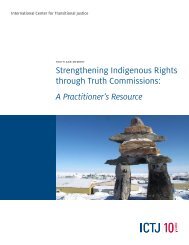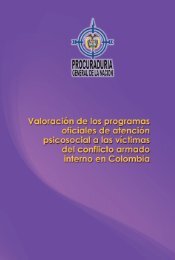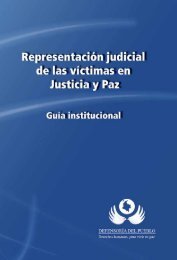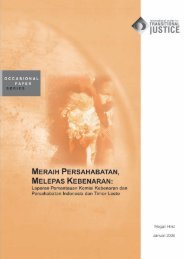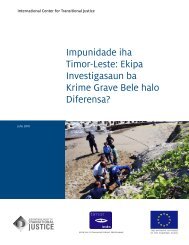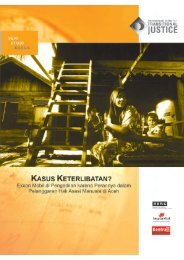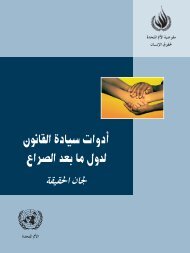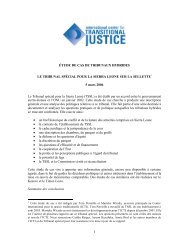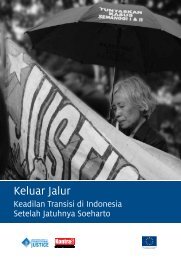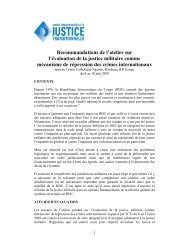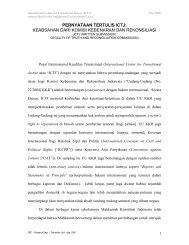Truth Telling and Reconciliation in Uganda - International Center for ...
Truth Telling and Reconciliation in Uganda - International Center for ...
Truth Telling and Reconciliation in Uganda - International Center for ...
Create successful ePaper yourself
Turn your PDF publications into a flip-book with our unique Google optimized e-Paper software.
Confront<strong>in</strong>g the Past:<strong>Truth</strong> <strong>Tell<strong>in</strong>g</strong> <strong>and</strong> <strong>Reconciliation</strong><strong>in</strong> Ug<strong>and</strong>aICTJ Ug<strong>and</strong>aConfront<strong>in</strong>g the Past: <strong>Truth</strong> <strong>Tell<strong>in</strong>g</strong> <strong>and</strong><strong>Reconciliation</strong> <strong>in</strong> Ug<strong>and</strong>aIntroductionSeptember 2012<strong>Truth</strong> tell<strong>in</strong>g is recognized as one of the important transitional justice measures <strong>for</strong>redress<strong>in</strong>g the legacies of abuse <strong>and</strong> respond<strong>in</strong>g to human rights violations <strong>and</strong> harms thatoccur dur<strong>in</strong>g repression or conflict. Other measures that can serve justice, promote the ruleof law, <strong>and</strong> achieve reconciliation <strong>in</strong>clude crim<strong>in</strong>al prosecutions, reparations, <strong>and</strong> <strong>in</strong>stitutionalre<strong>for</strong>m. 1 These measures should be implemented <strong>in</strong> a holistic, mutually re<strong>in</strong><strong>for</strong>c<strong>in</strong>g manner.<strong>Truth</strong> tell<strong>in</strong>g plays a critical role <strong>in</strong> acknowledg<strong>in</strong>g the wrongs suffered by victims, foster<strong>in</strong>greconciliation, community heal<strong>in</strong>g, <strong>and</strong> prevent<strong>in</strong>g the recurrence of the past abuses <strong>in</strong> postconflictsocieties. Establish<strong>in</strong>g the truth about past violations will not only help determ<strong>in</strong>ethe most appropriate remedies to be offered to victims, but it will also help identify thenecessary re<strong>for</strong>ms that can prevent such violations from happen<strong>in</strong>g aga<strong>in</strong>.Right to <strong>Truth</strong><strong>Truth</strong> tell<strong>in</strong>g orig<strong>in</strong>ates <strong>in</strong> the right to truth, which is an evolv<strong>in</strong>g legal concept <strong>in</strong><strong>in</strong>ternational law. 2 The right to truth imposes an obligation on states to provide victims <strong>and</strong>society at large with <strong>in</strong><strong>for</strong>mation about the violations <strong>and</strong> abuses that took place dur<strong>in</strong>gconflict. It also requires the state to preserve <strong>in</strong><strong>for</strong>mation <strong>for</strong> public memory. The right totruth has its historical roots <strong>in</strong> the struggles of families of the disappeared <strong>in</strong> Lat<strong>in</strong> Americathat sought to compel the authorities to disclose <strong>in</strong><strong>for</strong>mation about the fate of theirrelatives. 3Under <strong>in</strong>ternational law, the right to truth is enshr<strong>in</strong>ed <strong>in</strong> a number of <strong>in</strong>ternational<strong>in</strong>struments <strong>and</strong> nonb<strong>in</strong>d<strong>in</strong>g resolutions like the UN Updated Pr<strong>in</strong>ciples <strong>for</strong> the Protection<strong>and</strong> Promotion of Human Rights through Action to Combat Impunity (Updated Pr<strong>in</strong>cipleson Impunity). Pr<strong>in</strong>ciple 2 stipulates that “[e]very person has the <strong>in</strong>alienable right to know thetruth about past events concern<strong>in</strong>g the perpetration of he<strong>in</strong>ous crimes <strong>and</strong> about thecircumstances <strong>and</strong> reasons that led, through massive or systematic violations, to the1 United Nations Security Council, Report of the Secretary General on the rule of law <strong>and</strong> transitional justice <strong>in</strong> conflict <strong>and</strong>post-conflict societies (S/2004/616), (August, 3, 2004) paragraph 82 UN Commission on Human Rights, Human Rights Resolution 2005/66: Right to the <strong>Truth</strong>, E/CN.4/RES/2005/66 (April,20, 2005)3 Report of OHCHR on Promotion <strong>and</strong> Protection of Human Rights Study on the Right to the <strong>Truth</strong>, E/CN.4/2006/91,(February 8, 2006)1
Confront<strong>in</strong>g the Past:<strong>Truth</strong> <strong>Tell<strong>in</strong>g</strong> <strong>and</strong> <strong>Reconciliation</strong><strong>in</strong> Ug<strong>and</strong>aperpetration of those crimes.” 4 Furthermore, the <strong>International</strong> Convention <strong>for</strong> theProtection of All Persons from En<strong>for</strong>ced Disappearances upholds the right to know <strong>in</strong>situations of disappearance. 5 Article 24, (2), stipulates that victims have the right to know thetruth regard<strong>in</strong>g the circumstances of the en<strong>for</strong>ced disappearance, the progress <strong>and</strong> results ofthe <strong>in</strong>vestigation, <strong>and</strong> the fate of the disappeared person; <strong>and</strong> state parties have an obligationto take appropriate measures <strong>in</strong> this regard. The UN Commission on Human Rights <strong>in</strong> itsresolution 2005/66 “[r]recognizes the importance of respect<strong>in</strong>g <strong>and</strong> ensur<strong>in</strong>g the right to thetruth so as to contribute to end<strong>in</strong>g impunity <strong>and</strong> to promote <strong>and</strong> protect human rights.”Pr<strong>in</strong>ciple 24 of the Basic Pr<strong>in</strong>ciples <strong>and</strong> Guidel<strong>in</strong>es on the Right to a Remedy <strong>and</strong> Reparation<strong>for</strong> Victims of Gross Violations of <strong>International</strong> Human Rights <strong>and</strong> Serious Violations ofHumanitarian Law (Basic Pr<strong>in</strong>ciples) provides that the right to reparations of the victim<strong>in</strong>cludes “verification of the facts <strong>and</strong> full <strong>and</strong> public disclosure of the truth.” 6At a regional level, the Inter-American Commission held that the right to truth can be found<strong>in</strong> the right to a fair trial, the right to freedom of expression, <strong>and</strong> the right to judicialprotections. 7 The African Convention on Human <strong>and</strong> People’s Rights subsumes the right totruth under the right to an “effective remedy,” which <strong>in</strong>cludes access to justice <strong>and</strong>reparation <strong>for</strong> harm suffered. The convention promises victims of violations “access to thefactual <strong>in</strong><strong>for</strong>mation concern<strong>in</strong>g the violations.”Mechanisms to Implement Right to <strong>Truth</strong><strong>Truth</strong> seek<strong>in</strong>g can be achieved through a wide range of approaches, namely commissions of<strong>in</strong>quiry, fact-f<strong>in</strong>d<strong>in</strong>g missions, ad hoc parliamentary committee hear<strong>in</strong>gs, exhumationprocesses, Crim<strong>in</strong>al justice processes <strong>and</strong> documentation.Crim<strong>in</strong>al Justice ProcessesCrim<strong>in</strong>al justice is one means of uphold<strong>in</strong>g the right to truth. 8 Dur<strong>in</strong>g a crim<strong>in</strong>al trial,contested facts are rigorously scrut<strong>in</strong>ized us<strong>in</strong>g established evidentiary <strong>and</strong> proceduralst<strong>and</strong>ards to establish the truth. However, truth tell<strong>in</strong>g through crim<strong>in</strong>al processes may notalways satisfy a victim’s right to truth because courts seek may only seek to establish amicroscopic truth to prove certa<strong>in</strong> elements of crime, <strong>and</strong> prosecutors could omit facts,which are relevant to victims yet are regarded as irrelevant <strong>and</strong> <strong>in</strong>admissible under the rulesof evidence.<strong>Truth</strong> Commissions <strong>and</strong> Commissions of InquiryAt a national level, truth commissions <strong>and</strong> commissions of <strong>in</strong>quiry which are non judicialfact-f<strong>in</strong>d<strong>in</strong>g bodies could be established to <strong>in</strong>vestigate past human rights abuses thatoccurred dur<strong>in</strong>g a specified time. 9 A conventional commission of <strong>in</strong>quiry is essentially amechanism through which a head of state can obta<strong>in</strong> <strong>in</strong><strong>for</strong>mation <strong>and</strong> advice. The functionsof a commission are to determ<strong>in</strong>e facts underly<strong>in</strong>g serious problems, abuses, orcontroversies, <strong>and</strong> to advise the executive <strong>and</strong>/or legislative branches on how to addressthem.4 The UN Updated Pr<strong>in</strong>ciples <strong>for</strong> the Protection <strong>and</strong> Promotion of Human Rights through Action to Combat ImpunityE/CN.4/2005/102/Add.1 (February 18, 2005)5 <strong>International</strong> Convention <strong>for</strong> the Protection of All Persons from En<strong>for</strong>ced Disappearance General Assembly ResolutionA/61/177, (December 20, 2006)6 CHR Resolution 2005/35, April 19, 2005; ECOSOC Resolution 2005/35, (July 25, 2005), Pr<strong>in</strong>ciple 247 Velásquez Rodríguez, Vs. Honduras Inter-American Commission, Ct. H.R., (Ser. C) No. 4, 77 (1988)8 Report of OHCHR on Promotion <strong>and</strong> Protection of Human Rights Study on the Right to the <strong>Truth</strong>. E/CN.4/2006/91.9 Pricilla Hayner, “Fifteen <strong>Truth</strong> Commissions 1974-1994: a Comparative Study,” Human Rights Quarterly, Vol. 16, No. 4(November 1994): 597–665.2
Confront<strong>in</strong>g the Past:<strong>Truth</strong> <strong>Tell<strong>in</strong>g</strong> <strong>and</strong> <strong>Reconciliation</strong><strong>in</strong> Ug<strong>and</strong>aA truth commission is also a commission of <strong>in</strong>quiry, but it does substantially more. A truthcommission is required not only to establish an accurate, impartial account of the past, butalso to address the needs of victims <strong>and</strong> recommend measures to prevent the repetition ofconflict. A truth commission is expected to <strong>in</strong>itiate the important tasks of restor<strong>in</strong>g shatteredlives <strong>and</strong> rebuild<strong>in</strong>g destroyed <strong>and</strong> discredited <strong>in</strong>stitutions.Usually they pursue their m<strong>and</strong>ate by conduct<strong>in</strong>g <strong>in</strong>vestigations, research, <strong>and</strong> hold<strong>in</strong>g publichear<strong>in</strong>gs <strong>in</strong>to atrocities of the past that <strong>in</strong>clude abuses of power as well as economic crimes.Unlike crim<strong>in</strong>al trials, truth commissions enjoy a wider m<strong>and</strong>ate that enables them to delve<strong>in</strong>to the underly<strong>in</strong>g causes of the conflict.Establish<strong>in</strong>g a truth commission requires significant plann<strong>in</strong>g <strong>and</strong> wide stakeholderparticipation to ensure credibility <strong>and</strong> legitimacy. This can be done by consult<strong>in</strong>g withstakeholders to achieve a consensus on the commission’s legal framework. The enabl<strong>in</strong>g lawshould ensure that the commission is <strong>in</strong>dependent <strong>and</strong> immune from political manipulation.A good way to establish credibility is to appo<strong>in</strong>t commissioners who are above reproach <strong>and</strong>considered as fair <strong>and</strong> impartial. <strong>Truth</strong> commissions should have sufficient accessibleresources to carry out their m<strong>and</strong>ate, <strong>and</strong> they should have the power to compel theproduction of evidence as well as necessary witness testimony. Commissions must <strong>in</strong>sist onprocedural fairness to ensure a just outcome. Procedural rights that should be respected<strong>in</strong>clude the right to be heard, the right aga<strong>in</strong>st self-<strong>in</strong>crim<strong>in</strong>ation, <strong>and</strong> the right to legalrepresentation.Unofficial <strong>Truth</strong>-Seek<strong>in</strong>g ProcessesWhen political will is lack<strong>in</strong>g, unofficial truth seek<strong>in</strong>g can be pursued <strong>in</strong> place of officialprocesses at the community level.This approach might closely resemble official truth seek<strong>in</strong>g. It is characterized by a focus on<strong>in</strong>vestigat<strong>in</strong>g systematic human rights abuses, giv<strong>in</strong>g a voice to victims, <strong>and</strong> secur<strong>in</strong>g theenthusiastic <strong>in</strong>volvement of civil society. These groups can undertake <strong>in</strong>vestigations,document human rights abuses, publish reports, hold community meet<strong>in</strong>gs, <strong>and</strong> pursuecommunity-led memorials such as those held annually to commemorate massacres <strong>in</strong> thenorthern Ug<strong>and</strong>an communities of Barlonyo, Atiak, <strong>and</strong> Lukodi.Role of Civil SocietyCivil society <strong>in</strong>put can help determ<strong>in</strong>e the m<strong>and</strong>ate of the truth seek<strong>in</strong>g, the periods to becovered <strong>and</strong> the types of violations to be <strong>in</strong>vestigated. For <strong>in</strong>stance, civil society <strong>in</strong> SierraLeone was <strong>in</strong>volved <strong>in</strong> many aspects of the truth commission: lobby<strong>in</strong>g <strong>for</strong> its creationdur<strong>in</strong>g the Lome peace process; organiz<strong>in</strong>g consultations on the draft legislation; conduct<strong>in</strong>gstudies on the relationship between traditional justice <strong>and</strong> the truth commission; devis<strong>in</strong>gawareness-rais<strong>in</strong>g programs; tak<strong>in</strong>g statements; provid<strong>in</strong>g support to victims; giv<strong>in</strong>g <strong>in</strong>put<strong>in</strong>to the f<strong>in</strong>al recommendations; publiciz<strong>in</strong>g the f<strong>in</strong>al report; <strong>and</strong> creat<strong>in</strong>g awareness on itsf<strong>in</strong>d<strong>in</strong>gs <strong>and</strong> recommendations.Pursu<strong>in</strong>g Right to <strong>Truth</strong> <strong>in</strong> Ug<strong>and</strong>aThe debate on truth tell<strong>in</strong>g <strong>in</strong> Ug<strong>and</strong>a potentially goes far beyond the 2006-2008 Jubanegotiations between the government <strong>and</strong> rebels of the Lord’s Resistance Army (LRA). Atissue is Ug<strong>and</strong>a’s exceptionally violent history s<strong>in</strong>ce <strong>in</strong>dependence, a history that itself hasbeen <strong>in</strong>fluenced by pre-<strong>in</strong>dependence factors. Coups, oppressive regimes, <strong>and</strong> armedrebellions led to mass kill<strong>in</strong>gs, the disappearance of hundreds of thous<strong>and</strong>s of people, <strong>and</strong>3
Confront<strong>in</strong>g the Past:<strong>Truth</strong> <strong>Tell<strong>in</strong>g</strong> <strong>and</strong> <strong>Reconciliation</strong><strong>in</strong> Ug<strong>and</strong>awidespread destruction of property. In the past two decades alone, Ug<strong>and</strong>a has experiencedmore than twenty armed conflicts <strong>in</strong> different parts of the country. The most protracted <strong>and</strong>bloodiest raged <strong>for</strong> two decades <strong>in</strong> northern Ug<strong>and</strong>a between the government <strong>and</strong> the LRA;thous<strong>and</strong>s of people were killed, abducted, raped, mutilated, <strong>and</strong> displaced.Ug<strong>and</strong>a has made previous attempts to address the gross of human rights violations <strong>and</strong>disappearances. The first was through the 1974 Commission of Inquiry <strong>in</strong>to theDisappearances of People <strong>in</strong> Ug<strong>and</strong>a, which Idi Am<strong>in</strong> established to <strong>in</strong>vestigate thedisappearances of people dur<strong>in</strong>g the <strong>for</strong>mative years of his regime. 10 However political<strong>in</strong>terference <strong>and</strong> <strong>in</strong>timidation prevented the implementation of the recommendationsconta<strong>in</strong>ed <strong>in</strong> the commission’s report.When President Yoweri Museveni came <strong>in</strong>to power <strong>in</strong> 1986, he established the Commissionof Inquiry <strong>in</strong>to the Violation of Human Rights to <strong>in</strong>vestigate human rights violations underpast regimes <strong>and</strong> to establish a path towards national heal<strong>in</strong>g. 11 Like the 1974 commission,this commission faced a challenge of lack of required political will <strong>and</strong> resources to executeits m<strong>and</strong>ate effectively, <strong>and</strong> its recommendations were never fully implemented. 12 As aconsequence, most of the perpetrators rema<strong>in</strong> at large <strong>and</strong> have never been held accountable<strong>for</strong> alleged crimes, <strong>and</strong> many victims have never been recognized nor received justice.Neither of these two commissions had any significant impact.To comprehensively address the legacies of mass human rights abuse <strong>and</strong> violations, Ug<strong>and</strong>aneeds to courageously confront the underly<strong>in</strong>g causes beh<strong>in</strong>d its bloody past through anobjective, <strong>in</strong>dependent, <strong>in</strong>clusive, <strong>and</strong> trans<strong>for</strong>mational national process.The rationale <strong>for</strong> truth tell<strong>in</strong>g <strong>in</strong> Ug<strong>and</strong>a would revolve around the need to f<strong>in</strong>d last<strong>in</strong>gsolutions to the root causes of conflict by recommend<strong>in</strong>g the necessary political, economic,<strong>and</strong> social re<strong>for</strong>ms. A truth-seek<strong>in</strong>g process would need to identify ways of entrench<strong>in</strong>g therule of law <strong>and</strong> respect <strong>for</strong> human rights—two fundamental pillars of a democratic society.However, the big question is which model of truth tell<strong>in</strong>g process should Ug<strong>and</strong>a adopt?Until now, there does not appear to be much political will or appetite <strong>for</strong> a full SouthAfrican model of a truth commission, at least at the official level. Conversely, public op<strong>in</strong>ion<strong>and</strong> studies have repeatedly <strong>in</strong>dicated that the desire <strong>for</strong> truth seek<strong>in</strong>g <strong>in</strong> Ug<strong>and</strong>a is strong<strong>and</strong> that it is seen as a real priority by people <strong>in</strong> the regions affected by conflict. 13The Juba agreement on accountability <strong>and</strong> reconciliation <strong>and</strong> its annexure proposes theestablishment of a “body” whose m<strong>and</strong>ate shall be to <strong>in</strong>quire “<strong>in</strong>to the past <strong>and</strong> relatedmatters.” It avoids the term “commission,” although many of the listed functionsremarkably resemble those ord<strong>in</strong>arily assigned to truth commissions. The Refugee LawProject (RLP), as part of its Beyond Juba project, has <strong>for</strong> some time been work<strong>in</strong>g on anational reconciliation bill that similarly avoids the suggestion of a truth commission, <strong>and</strong><strong>in</strong>stead refers to a “<strong>for</strong>um” that would coord<strong>in</strong>ate bodies charged with implement<strong>in</strong>gcomprehensive solutions <strong>and</strong> accountability <strong>and</strong> reconciliation <strong>in</strong> Ug<strong>and</strong>a. 14 The bill goes10 Commission of Inquiry <strong>in</strong>to the Disappearances of People <strong>in</strong> Ug<strong>and</strong>a, Legal Notice No. 2 of 1974, (June 30, 1974)11 The Commission of Inquiry Act Legal Notice No. 5 of 1986. Report of the Commission of Inquiry <strong>in</strong>to Violations ofHuman Rights (Kampala: UPPC, 1994), 3-4.12 The Commission of Inquiry <strong>in</strong>to the Disappearances of People <strong>in</strong> Ug<strong>and</strong>a. Legal Notice No. 2 of 1974. (June 30, 1974)13 Phuong Pham et al. “When the War Ends: A Population-Based Survey on Attitudes about Peace, Justice <strong>and</strong> SocialReconstruction <strong>in</strong> Northern Ug<strong>and</strong>a” Human Rights <strong>Center</strong> at the University of Cali<strong>for</strong>nia at Berkeley, Payson <strong>Center</strong> <strong>for</strong><strong>International</strong> Development at Tulane University, <strong>and</strong> ICTJ, December 2007. See also “Mak<strong>in</strong>g Peace Our Own: Victims'Perceptions of Accountability, <strong>Reconciliation</strong> <strong>and</strong> Transitional Justice <strong>in</strong> Northern Ug<strong>and</strong>a”, OHCHR, 2007.14 National <strong>Reconciliation</strong> Bill Draft, 2008.4
<strong>in</strong>to some detail on the structures that would be put <strong>in</strong>to place, <strong>and</strong> it is part of an ongo<strong>in</strong>gdiscussion that needs to be exp<strong>and</strong>ed.Confront<strong>in</strong>g the Past:<strong>Truth</strong> <strong>Tell<strong>in</strong>g</strong> <strong>and</strong> <strong>Reconciliation</strong><strong>in</strong> Ug<strong>and</strong>aVictims <strong>and</strong> members of affected communities <strong>in</strong> northern Ug<strong>and</strong>a have repeatedly called<strong>for</strong> a truth- tell<strong>in</strong>g process that they believe would illum<strong>in</strong>ate the root causes of the conflict,publicly acknowledge the plight of victims, <strong>and</strong> provide access to appropriate redress <strong>and</strong>reconciliation with perpetrators. They also believe that truth tell<strong>in</strong>g can contribute to themoral rehabilitation of perpetrators.A report by Ug<strong>and</strong>a government’s Justice Law <strong>and</strong> Order Sector on traditional justicemechanisms, truth tell<strong>in</strong>g, <strong>and</strong> national reconciliation, notes that communities affected byconflict preferred a “community based truth tell<strong>in</strong>g” process led by <strong>in</strong>stitutions at the locallevel to address the <strong>in</strong>tercommunity <strong>and</strong> <strong>in</strong>ter-tribal conflicts that have taken place across thecountry. 15 The report further suggests that cultural <strong>and</strong> religious <strong>in</strong>stitutions could spearheadthese processes because they are trusted <strong>and</strong> have previously played a critical role <strong>in</strong>promot<strong>in</strong>g peace <strong>and</strong> reconciliation when state authorities were absent.Victims also suggested that community documentation projects need to be pursuedalongside commemoration ceremonies <strong>and</strong> mediation <strong>and</strong> reconciliation processes currentlybe<strong>in</strong>g conducted by some community structures like the District <strong>Reconciliation</strong> PeaceTeams. They would like these ef<strong>for</strong>ts l<strong>in</strong>ked to a national truth-tell<strong>in</strong>g process so theirsuffer<strong>in</strong>g would be acknowledged at a national level. 16Ug<strong>and</strong>a should not necessarily seek to follow any of the models that have been adopted <strong>in</strong>other countries. One of the most attractive aspects of truth-seek<strong>in</strong>g processes is their relativeflexibility <strong>in</strong> design. <strong>Truth</strong> tell<strong>in</strong>g should be adapted to a country’s circumstances.Pend<strong>in</strong>g <strong>for</strong>mal truth seek<strong>in</strong>g, unofficial truth seek<strong>in</strong>g should be pursued. One area thatcould be very important to explore is the potential <strong>for</strong> truth seek<strong>in</strong>g through traditionaljustice ceremonies <strong>and</strong> how facts gathered through traditional ceremonies can be compiled<strong>and</strong> centralized. 17The <strong>International</strong> <strong>Center</strong> <strong>for</strong> TransitionalJustice works to redress <strong>and</strong> prevent themost severe violations of human rightsby confront<strong>in</strong>g legacies of mass abuse.ICTJ seeks holistic solutions to promoteaccountability <strong>and</strong> create just <strong>and</strong>peaceful societies. To learn more, visitwww.ictj.orgIn conclusion, national heal<strong>in</strong>g <strong>and</strong> reconciliation <strong>in</strong> Ug<strong>and</strong>a requires a multilayered truthtell<strong>in</strong>gprocess comprised of community <strong>and</strong> national processes that are mutually re<strong>in</strong><strong>for</strong>c<strong>in</strong>g<strong>and</strong> should not be mutually exclusive, as proposed by the JLOS report. A national truthtell<strong>in</strong>gbody should address issues of state responsibility. Importantly a national truth-tell<strong>in</strong>gprocess would be <strong>in</strong> a strong position to solicit <strong>and</strong> consider submissions <strong>for</strong> <strong>in</strong>stitutionalre<strong>for</strong>ms <strong>and</strong> reparations proposed by community-based processes throughout Ug<strong>and</strong>a.Additionally it could recommend the necessary measures to redress the suffer<strong>in</strong>g of victims<strong>and</strong> prevent the reoccurrence of conflict <strong>and</strong> abuse.ICTJ New York5 Hanover Square, Floor 24New York, NY USA 1000415 “Study report on Traditional Justice, <strong>Truth</strong> tell<strong>in</strong>g <strong>and</strong> National <strong>Reconciliation</strong> Ug<strong>and</strong>a”, Justice Law <strong>and</strong> Order SectorKampala: July 2012.16 Participants’ comments dur<strong>in</strong>g the civil society dialogue on truth seek<strong>in</strong>g <strong>in</strong> Gulu, March 29 , 2012.17 “The Cool<strong>in</strong>g of Hearts: Community <strong>Truth</strong>-<strong>Tell<strong>in</strong>g</strong> <strong>in</strong> Acholil<strong>and</strong>”. The Justice <strong>and</strong> <strong>Reconciliation</strong> Project: July 2007.5


